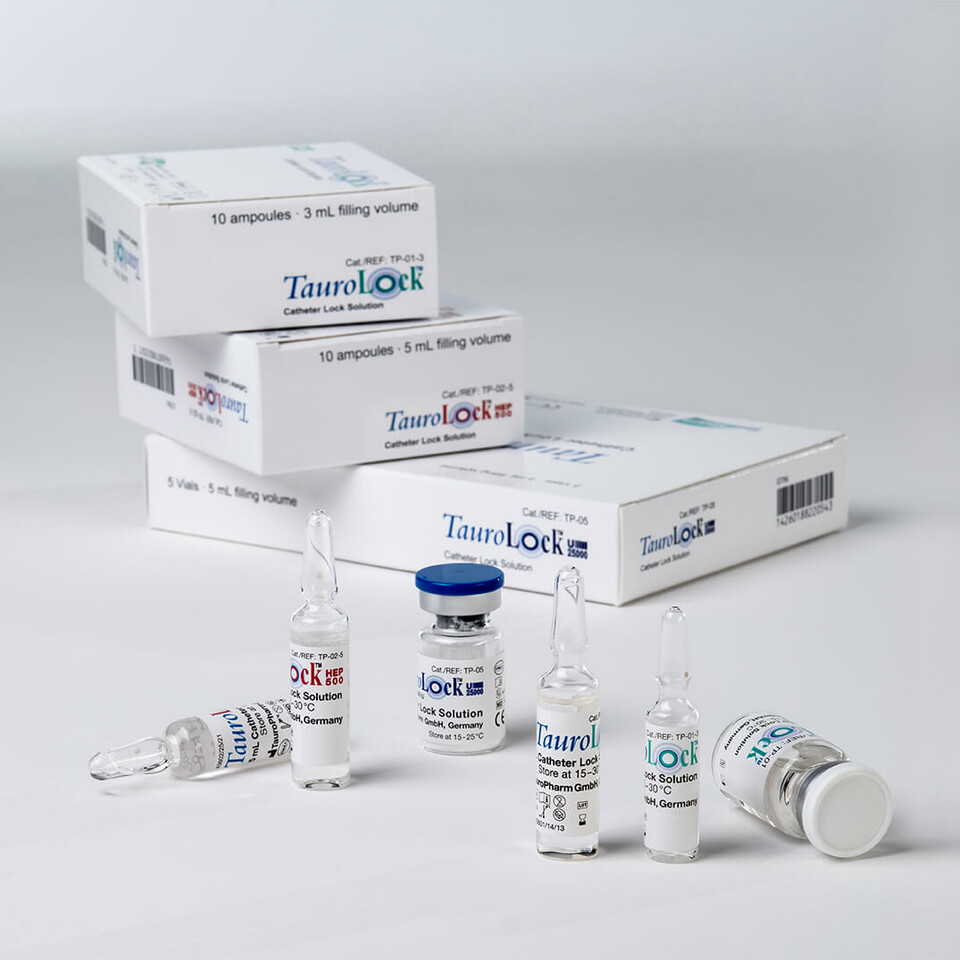NutriLock™ and TauroLock™ solutions
Safety for central-venous catheters
Central-venous catheters (CVC) help patients in many different contexts – from dialysis and cancer treatment to parenteral nutrition. But while vascular access devices (VAD) can save lives, they can also lead to potentially life-threatening infections.
Our lock solutions prevent catheter-related complications by combining several effects in one product:
antimicrobial to avoid infections
antibiofilm to keep catheters clean
antiocclusive to maintain a good flow rate
Our product range includes different variants to meet the patients’ individual needs. The main active ingredients (used in varying compositions) are taurolidine, heparin, citrate, and urokinase.
Why do you need a catheter lock solution?
If a CVC system does not remain completely sanitary at all times, it can cause dangerous infections. It is also important to avoid the formation of biofilm, a three-dimensional matrix for germs. How can we protect central-venous catheters against those complications? Unlike traditional lock solutions, we rely on a combination of active ingredients to ensure multiple effects at once.
Taurolidine is antimicrobial
It kills more than 500 germs without generating resistance. This includes MRSA (methicillin-resistentant staphylococcus aureus) and VRE (vancomycin-resistant enterococci).
Heparin and citrate
are anticoagulant
They prevent occlusions and sustain an adequate flow rate.
Urokinase is fibrinolytic
It can break up blood clotting in its early stages.

Used in the right concentration, these four substances provide the basis for a lock solution that effectively prevents catheter-related bloodstream infections (CRBSI) and occlusions.
When do you need NutriLock™ or TauroLock™ solutions?
Our products are suitable for a variety of patients. We recommend our lock solutions for all central access devices (CAD), such as those needed in:
Dialysis
Patients who depend on extracorporeal blood cleansing due to permanent kidney failure can use TauroLock™-HEP500, TauroLock™-U25.000, or TauroLock™.
Intensive care units
Patients in ICU can be treated with TauroLock™ or TauroLock™-HEP100, according to their medical condition.
| Product | Ingredients | Recommended Fields of Application |
|---|---|---|
 |
|
|
 |
|
|
 |
|
|
 |
|
|
 |
|
|
Each catheter lock solution from our product range has proven safe and efficient. Testings have shown that taurolidine has a good biocompatibility and clinical tolerability: Once the substance enters the body through the VAD, it degrades to taurine (amino acid), carbon dioxide, and water.
More about our lock solutions
On our website, you can find detailed information about the usage and benefits of our products. Any particular questions or concerns? We are happy to help, feel free to contact us anytime:
“In vitro, the antimicrobial agent taurolidine inhibited virtually all of the bacteria tested, including vancomycin-resistant enterococci, oxacillin-resistant staphylococci, and Stenotrophomonas maltophilia, at concentrations between 250 and 2,000 mg/ml. Taurolidine was not effective in experimental endocarditis. While it appears unlikely that this antimicrobial would be useful for systemic therapy, its bactericidal activity and the resistance rates found (<10-9) are favorable indicators for its possible development for topical use.”
For personal inquiries, feel free to contact us via phone or email.
Our international distributors based in more than 50 countries will answer your requests ASAP.


